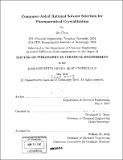Computer-aided rational solvent selection for pharmaceutical crystallization
Author(s)
Chen, Jie, Ph. D. Massachusetts Institute of Technology
DownloadFull printable version (15.50Mb)
Other Contributors
Massachusetts Institute of Technology. Dept. of Chemical Engineering.
Advisor
Bernhardt L. Trout.
Terms of use
Metadata
Show full item recordAbstract
Solvents play an important role in crystallization, a commonly used separation and purification technique in the pharmaceutical, chemical and food industries. They affect crystal properties such as particle size distribution, morphology, polymorphism etc. and therefore have consequences for the downstream processing of the solid material. Current solvent selection techniques for solution crystallization remain ad hoc and typically do not have a theoretical underpinning. Elucidation of the interactions between solvent and solute molecules and the mechanism underlying the solvent effects on each aspect of the crystal properties would be a major aid for the rational selection of solvents and also the development of crystallization processes. In this work we studied the effect of solvent on the polymorphism and morphology of organic crystals using molecular modeling techniques. The two most important contributions of this thesis are listed below. 1. We studied the self-assembly of solute molecules in solutions prior to nucleation for two polymorphic systems, tetrolic acid and glycine, using molecular dynamics simulations. We tested the existence of a link between the structure of the clusters formed in solution and the polymorphism of the crystals. Our results show that the link hypothesis succeeds in explaining the polymorph selection of tetrolic acid from different solvents. However it fails for glycine and thus should be used with caution. 2. We designed a computer-aided rational solvent selection procedure for improving the morphology of needle-like 2,6-dihydroxybenzoic acid form 2 crystal. We also experimentally grew 2,6-dihydroxybenzoic acid form 2 crystals using the solvent mixture suggested by computer simulations, which do exhibit reduced aspect ratios. This computer-aided selection procedure can not only quickly identify an effective solvent or solvent mixture, but also provide mechanistic understandings of the underlying chemistry. It can also be extended to improve the morphology of other needle-like organic crystals easily.
Description
Thesis (Ph. D.)--Massachusetts Institute of Technology, Dept. of Chemical Engineering, 2010. Cataloged from PDF version of thesis. Includes bibliographical references (p. 131-135).
Date issued
2010Department
Massachusetts Institute of Technology. Department of Chemical EngineeringPublisher
Massachusetts Institute of Technology
Keywords
Chemical Engineering.